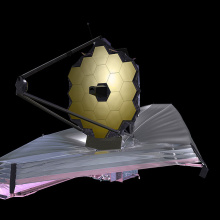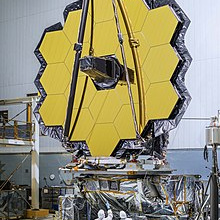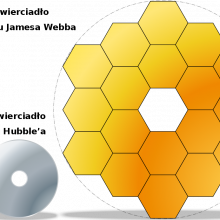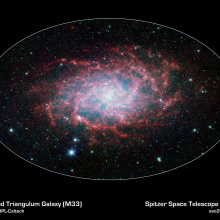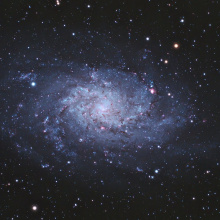February 19 is the Day of Polish Science. The date of this holiday is the birthday of Nicolaus Copernicus in appreciation of his outstanding contributions in the field of astronomy. This day is supposed to be an inspiration to follow in the footsteps of Polish researchers and strengthen interest in science. On this occasion, we take a look into the... young Universe.
The objectives of the James Webb Space Telescope (JWST) mission are to observe the first stars formed after the Big Bang, to study the formation and evolution of galaxies, and to investigate the formation of stars and planetary systems.
The recent launch of the JWST has caused a stir among astronomy enthusiasts. The first association is the continuation of the Hubble Telescope's (HST) 32-year mission. How these two observatories differ from each other is explained by dr hab. Marcin Wieśniak, prof. UG from the Faculty of Mathematics, Physics and Informatics UG.
The first differences are visible at first glance. HST has the form of a tube associated with the classic image of a telescope. The classical appearance is emphasised by the front flap, and the fact that it is a satellite is reminded mainly by the solar panels. The JWST looks more like a prop from a science fiction movie, with a bare array of gold mirrors placed on a large platform that will provide additional insulation from light. Hidden behind the main mirror is a set of sensitive cameras and spectrometers.
There is also a difference in size. The Hubble telescope has a mirror with an impressive diameter of 2.4 m. After its launch, however, it became apparent that producing very large mirrors honed to an accuracy of a few dozen atoms could be problematic. Several very large telescopes have been developed in which the main mirror is cut into smaller pieces, each of which is ground separately.
This is ideal for a large space telescope because the mirror can be rolled up, making the payload of the launcher significantly smaller. However, now that the telescope has arrived at its destination, many months of precise collimation of the entire six-metre system await the operators.
The increase in the size of the telescope does not necessarily mean a very dramatic improvement in the resolution of the images. The resolution is inversely proportional to the wavelength of the observed wave and, yes, it is possible to create instruments with a resolution 5 or 10 times higher than before, but this is still not enough to take pictures of the faces of extrasolar planets or even other stars.
On Earth, astronomers have tried to outdo each other with concepts of large telescopes (Large, Very Large, Giant, Extremely Large, Overwhelmingly Large), but a diameter of 100 m is the limit of our real possibilities. It is still not enough to see stars as a non-point objects.
In addition, while HST made history with a series of beautiful images in visible light, JWST will not have that chance, as it will be sensitive to red and near-infrared. This is dictated by the main goal of the mission, which is to observe the oldest galaxies. According to Hubble's law, the further away a galaxy is from us, the faster it moves away from us and the more its light is redshifted.
In addition, the light from the most distant galaxies is very faint. JWST, therefore, needs to collect a lot of low-energy, long infrared wavelengths for its observations. The reward for this effort will be the opportunity to observe how galaxies form into shapely ellipsoids and spirals. We will literally peek into the young Universe. Another task for which the Webb telescope will be indispensable is the search for water and organic matter in the atmospheres of exoplanets.
The position of the instruments is also an important difference. The Hubble telescope orbits the Earth at an altitude of about 616 km. This made it possible to carry out five maintenance missions, during which new cameras, optics and fuel for the thrusters were delivered. HST is expected to remain in service for several more years.
JWST has been placed at the Lagrange point L2 of the Earth-Sun system. It will be 1.5 million km away from us, and our planet will serve as a solar radiation screen. Previously, the William Hershel Space Observatory performed its tasks there. The long distance makes any mission very difficult, even the delivery of fuel, and the position of the telescope will have to be constantly corrected, as the L2 point is unstable. For these reasons, the length of the mission has been projected at 10 years. However, as it is a large instrument, this decade corresponds to several decades of the Hubble telescope.
On February 19 at 11.00 and 12.00 in the Hevelianum the achievements of Gdańsk scientists will be presented. The talk will be attended by the laureates of the Jan Hevelius Science Award of the City of Gdańsk: prof. Małgorzata Omilanowska-Kiljańczyk (humanities and social sciences category) and prof. Ewa Łojkowska (science and natural sciences category), who agreed to talk about their scientific path, achievements and inspirations.
Talks on Hevelianum' s Facebook and YouTube on February 19 (Saturday), at 11.00 and 12.00.
Media partners: Trojmiasto.pl, Ministry of Science and Higher Education, SPIN Society and Science Association.
Photo: Wikimedia, archive

